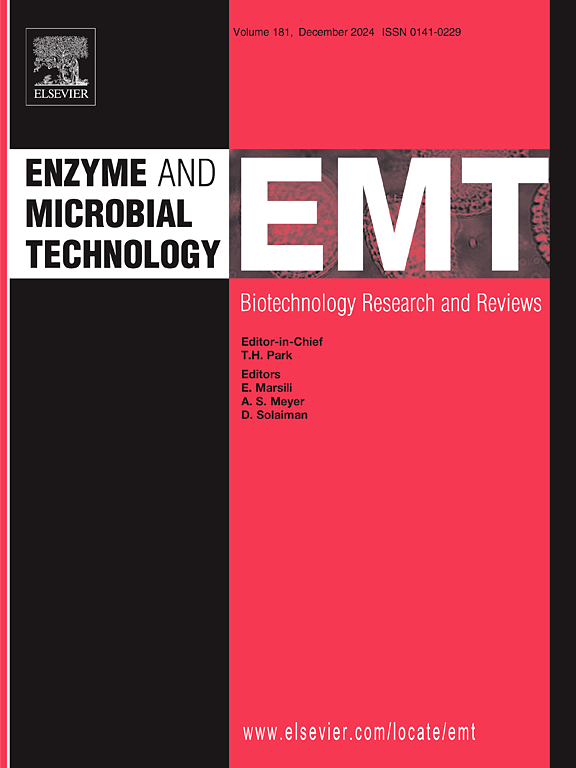利用生物物理和计算方法探索幽门螺杆菌组氨酸tRNA合成酶作为药物靶点
IF 3.7
3区 生物学
Q2 BIOTECHNOLOGY & APPLIED MICROBIOLOGY
引用次数: 0
摘要
幽门螺杆菌感染是一项重大的全球健康挑战,特别是由于抗生素耐药性日益普遍。本研究旨在通过表征幽门螺杆菌组氨酸tRNA合成酶(HpHRS)来确定新的治疗靶点,HpHRS是蛋白质生物合成所必需的酶。我们成功地克隆、表达和纯化HpHRS使用亲和层析和大小排斥层析技术。圆二色光谱显示,HpHRS与底物结合后构象发生了变化,α-螺旋结构明显减少,β-片结构明显增加。荧光猝灭研究证实了l -组氨酸和ATP与酶活性位点的结合。锌数据库的虚拟筛选鉴定出两个潜在的抑制剂ZINC39960778和ZINC30878996,它们比天然底物具有更高的亲和力。在100 ns以上进行的分子动力学模拟显示了稳定的蛋白质-配体相互作用,其中hrs -组氨酸腺苷酸单磷酸(HAM)复合物表现出最高的稳定性。自由能分析表明配体结合复合物的构象自由度大于载脂蛋白。这些发现为HpHRS的结构和功能提供了有价值的见解,有助于开发针对幽门螺杆菌中这一关键酶的新型抗菌药物。鉴于对抗生素耐药性的日益关注,本研究为设计针对幽门螺杆菌感染的新治疗策略提供了一条有希望的途径。进一步的研究应集中在对已确定的抑制剂进行实验验证和优化,以开发有效和选择性的HpHRS抑制剂作为潜在的抗菌候选药物。本文章由计算机程序翻译,如有差异,请以英文原文为准。
Exploring Helicobacter pylori Histidyl tRNA synthetase as a drug target using biophysical and computational approaches
Helicobacter pylori infections represent a significant global health challenge, particularly due to the increasing prevalence of antibiotic resistance. This study aims to identify novel therapeutic targets by characterising H. pylori Histidyl tRNA synthetase (HpHRS), an enzyme essential for protein biosynthesis. We successfully cloned, expressed, and purified HpHRS using affinity chromatography and size exclusion chromatography techniques. Circular dichroism spectroscopy revealed conformational changes in HpHRS upon substrate binding, with a notable decrease in α-helical content and an increase in β-sheet structures. Fluorescence quenching studies confirmed the binding of L-histidine and ATP to the enzyme's active site. Virtual screening of the ZINC database identified two potential inhibitors, ZINC39960778 and ZINC30878996, which exhibited higher affinities than the natural substrate. Molecular dynamics simulations conducted over 100 ns demonstrated stable protein-ligand interactions, with the HRS-Histidyl Adenylate Monophosphate (HAM) complex showing the highest stability. Free energy landscape analysis indicated greater conformational freedom in ligand-bound complexes than apoproteins. These findings provide valuable insights into the structure and function of HpHRS, contributing to the development of new antibacterial agents targeting this crucial enzyme in H. pylori. Given the growing concern regarding antibiotic resistance, this study presents a promising avenue for designing new therapeutic strategies against H. pylori infections. Further research should focus on the experimental validation of the identified inhibitors and optimisation to develop potent and selective HpHRS inhibitors as potential antibacterial candidates.
求助全文
通过发布文献求助,成功后即可免费获取论文全文。
去求助
来源期刊

Enzyme and Microbial Technology
生物-生物工程与应用微生物
CiteScore
7.60
自引率
5.90%
发文量
142
审稿时长
38 days
期刊介绍:
Enzyme and Microbial Technology is an international, peer-reviewed journal publishing original research and reviews, of biotechnological significance and novelty, on basic and applied aspects of the science and technology of processes involving the use of enzymes, micro-organisms, animal cells and plant cells.
We especially encourage submissions on:
Biocatalysis and the use of Directed Evolution in Synthetic Biology and Biotechnology
Biotechnological Production of New Bioactive Molecules, Biomaterials, Biopharmaceuticals, and Biofuels
New Imaging Techniques and Biosensors, especially as applicable to Healthcare and Systems Biology
New Biotechnological Approaches in Genomics, Proteomics and Metabolomics
Metabolic Engineering, Biomolecular Engineering and Nanobiotechnology
Manuscripts which report isolation, purification, immobilization or utilization of organisms or enzymes which are already well-described in the literature are not suitable for publication in EMT, unless their primary purpose is to report significant new findings or approaches which are of broad biotechnological importance. Similarly, manuscripts which report optimization studies on well-established processes are inappropriate. EMT does not accept papers dealing with mathematical modeling unless they report significant, new experimental data.
 求助内容:
求助内容: 应助结果提醒方式:
应助结果提醒方式:


